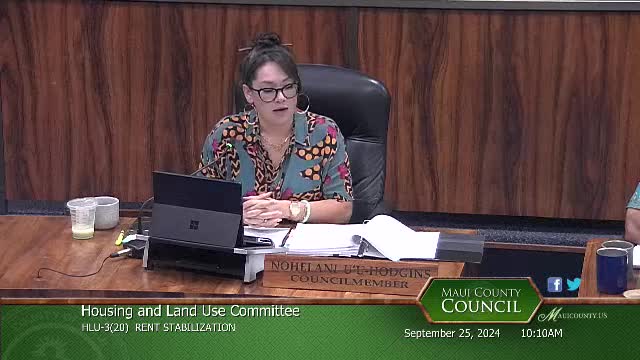Housing Crisis Deepens as Maui Faces Gentrification Challenges
September 25, 2024 | Maui County, Hawaii
This article was created by AI summarizing key points discussed. AI makes mistakes, so for full details and context, please refer to the video of the full meeting. Please report any errors so we can fix them. Report an error »

During a recent government meeting, discussions centered on the complexities of affordable housing calculations in Maui County, highlighting the need for more granular data to address local housing challenges. Member Rollins Fernandez raised a critical question regarding the lack of detailed breakdowns in affordable rental calculations, particularly why areas like Hana, Lanai, and Molokai are treated separately from the rest of Maui.
Chair Lee provided historical context, explaining that in the late 1990s, a decision was made to separate these areas from the broader Maui income structure due to perceived inequities. This decision was based on the belief that the economic conditions in these regions differed significantly from those on the main island of Maui. The use of census data to determine income standards was also established during this period.
However, as discussions progressed, it became evident that the housing landscape has evolved significantly over the past three decades. Member Hudgins emphasized the importance of revisiting these classifications, noting that many affordable housing units have become increasingly expensive due to gentrification, particularly in areas like Playa.
The conversation also touched on the necessity of breaking down housing data by ZIP codes, similar to practices in other regions, to better reflect the diverse needs and preferences of residents. Members expressed concern that without this detailed information, it would be challenging to address the housing crisis effectively, especially as residents seek to live closer to their communities and essential services.
The meeting underscored a growing recognition among officials that the current approach to affordable housing data may no longer suffice, prompting calls for a reevaluation of methodologies to ensure they align with the current realities faced by Maui's residents.
Chair Lee provided historical context, explaining that in the late 1990s, a decision was made to separate these areas from the broader Maui income structure due to perceived inequities. This decision was based on the belief that the economic conditions in these regions differed significantly from those on the main island of Maui. The use of census data to determine income standards was also established during this period.
However, as discussions progressed, it became evident that the housing landscape has evolved significantly over the past three decades. Member Hudgins emphasized the importance of revisiting these classifications, noting that many affordable housing units have become increasingly expensive due to gentrification, particularly in areas like Playa.
The conversation also touched on the necessity of breaking down housing data by ZIP codes, similar to practices in other regions, to better reflect the diverse needs and preferences of residents. Members expressed concern that without this detailed information, it would be challenging to address the housing crisis effectively, especially as residents seek to live closer to their communities and essential services.
The meeting underscored a growing recognition among officials that the current approach to affordable housing data may no longer suffice, prompting calls for a reevaluation of methodologies to ensure they align with the current realities faced by Maui's residents.
View full meeting
This article is based on a recent meeting—watch the full video and explore the complete transcript for deeper insights into the discussion.
View full meeting
